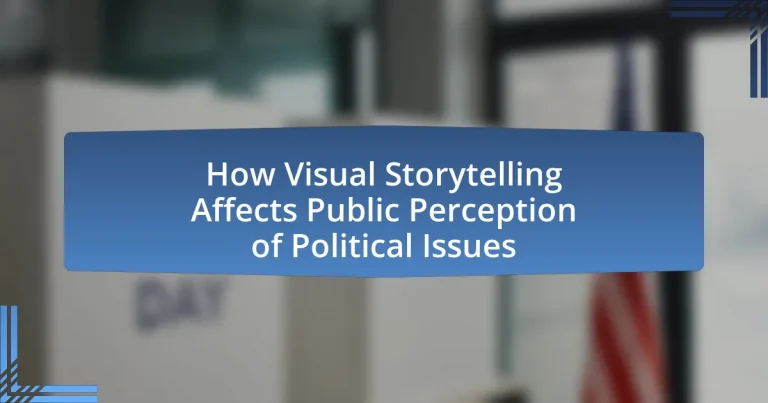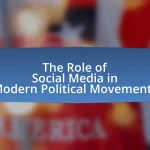The article examines how visual storytelling influences public perception of political issues, highlighting its ability to create emotional connections and simplify complex narratives. Key elements such as imagery, symbolism, and emotional appeal are discussed, along with the impact of design on the effectiveness of visual content. The article also addresses the role of social media in shaping demographic responses, the challenges of misinformation, and ethical considerations in visual narratives. Additionally, it explores future trends in visual storytelling, including advancements in technology and data visualization, emphasizing best practices for political communicators to enhance engagement and understanding among diverse audiences.
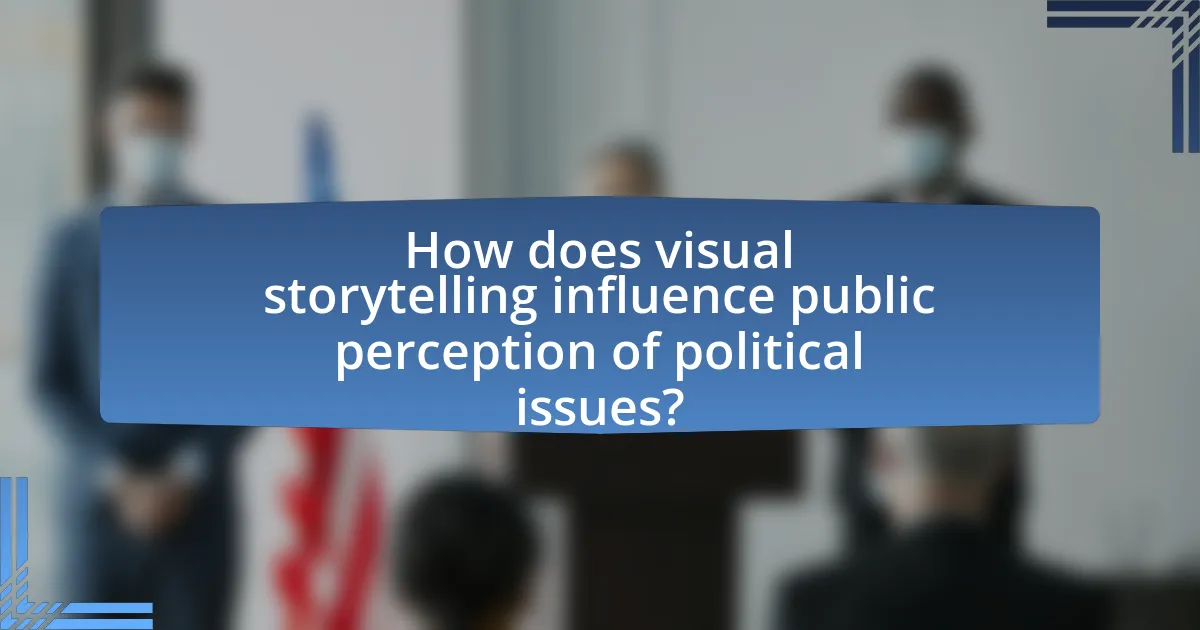
How does visual storytelling influence public perception of political issues?
Visual storytelling significantly shapes public perception of political issues by creating emotional connections and simplifying complex narratives. This method engages audiences more effectively than text alone, as studies show that visuals can increase information retention by up to 65%. For instance, political campaigns often utilize infographics and videos to convey their messages, making abstract concepts more relatable and understandable. Research from the Pew Research Center indicates that visual content on social media platforms can lead to higher engagement rates, influencing public opinion and mobilizing support for specific political agendas.
What are the key elements of visual storytelling in politics?
The key elements of visual storytelling in politics include imagery, symbolism, narrative structure, and emotional appeal. Imagery captures attention and conveys messages quickly, while symbolism allows complex ideas to be represented visually, enhancing understanding. Narrative structure organizes information in a compelling way, guiding the audience through a story that resonates with their experiences. Emotional appeal engages viewers on a personal level, influencing their perceptions and reactions to political issues. For instance, political campaigns often use powerful images and symbols, such as the American flag or iconic leaders, to evoke patriotism and connect with voters emotionally, thereby shaping public perception effectively.
How do images and videos shape narratives in political discourse?
Images and videos significantly shape narratives in political discourse by influencing public perception and emotional engagement. Visual content can evoke strong emotional responses, making complex political issues more relatable and understandable. For instance, during the 2016 U.S. presidential election, images and videos shared on social media platforms played a crucial role in framing candidates’ images and policies, often swaying public opinion. Research by the Pew Research Center indicates that 64% of Americans believe that visual content helps them understand political issues better, highlighting the effectiveness of images and videos in shaping narratives.
What role does design play in the effectiveness of visual storytelling?
Design plays a crucial role in the effectiveness of visual storytelling by enhancing clarity, engagement, and emotional impact. Effective design elements, such as color, typography, and layout, guide the viewer’s attention and facilitate understanding of complex narratives. For instance, studies show that visuals can increase information retention by up to 65% when combined with well-structured design, as highlighted in research by the University of Minnesota. This demonstrates that thoughtful design not only captures interest but also aids in conveying messages more powerfully, ultimately influencing public perception of political issues.
Why is visual storytelling important in political communication?
Visual storytelling is important in political communication because it enhances engagement and retention of information among audiences. Research indicates that visuals can increase information retention by up to 65% compared to text alone, making complex political issues more accessible and relatable. Furthermore, studies show that emotionally charged images can evoke stronger responses, influencing public opinion and mobilizing support for political causes. For instance, the use of powerful imagery in campaigns has been shown to significantly impact voter behavior and perceptions, as seen in the 2008 Obama campaign, which effectively utilized visual media to connect with diverse demographics.
How does visual storytelling enhance emotional engagement with political issues?
Visual storytelling enhances emotional engagement with political issues by creating relatable narratives that evoke empathy and personal connection. This method utilizes imagery, video, and graphics to present complex political topics in a digestible format, making them more accessible and impactful. Research indicates that visuals can increase information retention by up to 65%, as they stimulate emotional responses that text alone may not achieve. For instance, studies show that emotionally charged images related to social issues can lead to increased public support and activism, demonstrating the power of visual storytelling in shaping perceptions and motivating action.
What impact does visual storytelling have on information retention among the public?
Visual storytelling significantly enhances information retention among the public. Research indicates that individuals are 65% more likely to remember information when it is presented in a visual format compared to text alone. This is attributed to the brain’s ability to process images 60,000 times faster than text, leading to improved engagement and understanding. Furthermore, studies show that narratives combined with visuals can increase recall rates by up to 70%, as they create emotional connections that facilitate memory retention.
What challenges exist in using visual storytelling for political issues?
Visual storytelling for political issues faces several challenges, including oversimplification, bias, and misinterpretation. Oversimplification occurs when complex political narratives are reduced to easily digestible visuals, potentially leading to a lack of nuance and understanding among the audience. Bias is another significant challenge, as visuals can be selectively chosen or manipulated to support a particular political agenda, thereby skewing public perception. Misinterpretation arises when viewers project their own beliefs onto the visuals, which can distort the intended message. These challenges can hinder effective communication and understanding of political issues, ultimately affecting public discourse and decision-making.
How can misinformation be spread through visual storytelling?
Misinformation can be spread through visual storytelling by using misleading images or videos that distort reality. For example, manipulated visuals can create false narratives about political events, influencing public perception. Research indicates that visuals are processed faster than text, making them more impactful in shaping opinions. A study by the Pew Research Center found that 64% of Americans believe that fabricated news stories cause confusion about basic facts, highlighting the effectiveness of visual misinformation in altering perceptions.
What ethical considerations should be taken into account in visual political narratives?
Ethical considerations in visual political narratives include accuracy, representation, and manipulation. Accuracy ensures that visual content does not mislead the audience; for instance, using edited images can distort reality and misinform viewers about political issues. Representation involves portraying diverse perspectives fairly, avoiding stereotypes that can marginalize certain groups. Manipulation refers to the ethical implications of using emotional appeals or sensationalism to sway public opinion, which can undermine informed decision-making. These considerations are crucial as they directly impact public trust and the integrity of political discourse.
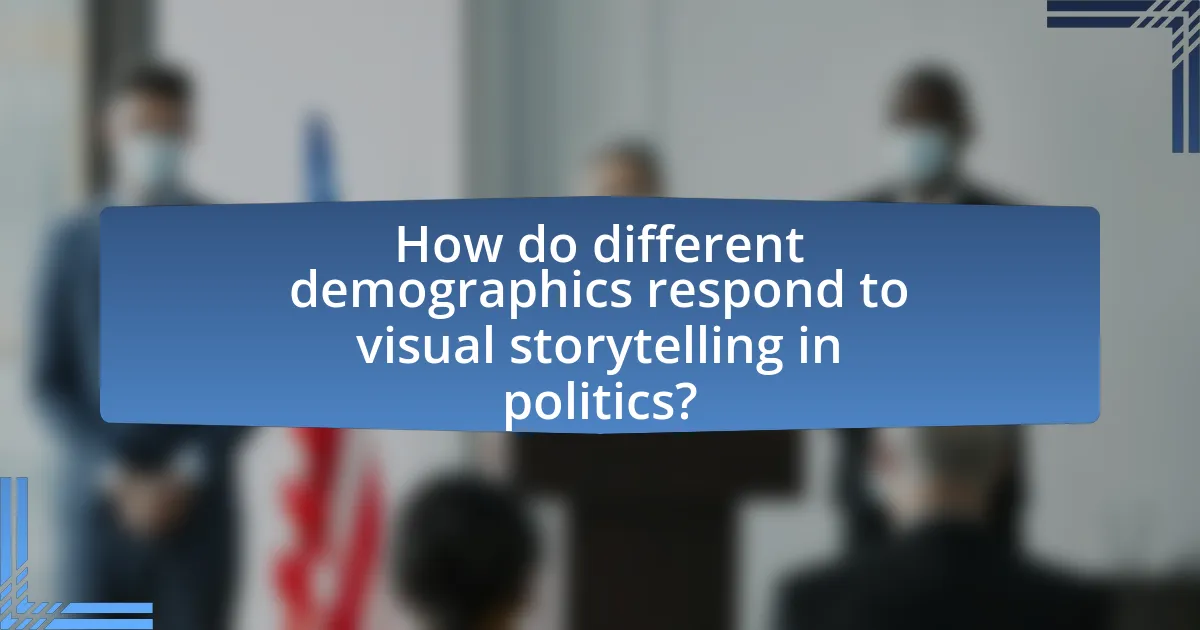
How do different demographics respond to visual storytelling in politics?
Different demographics respond to visual storytelling in politics in varied ways, influenced by factors such as age, education, and cultural background. Research indicates that younger audiences, particularly those aged 18-29, are more likely to engage with visual content, as they consume information primarily through social media platforms where visuals dominate. In contrast, older demographics may prefer traditional media formats, which can affect their receptiveness to visual storytelling.
Additionally, studies show that individuals with higher education levels tend to analyze visual narratives critically, while those with lower education levels may respond more emotionally to imagery. Cultural background also plays a significant role; for instance, visual storytelling that resonates with specific cultural values can enhance engagement and understanding among diverse groups.
For example, a study by the Pew Research Center found that 64% of adults aged 18-29 reported that visual content helped them understand political issues better, compared to only 38% of those aged 50 and older. This data underscores the importance of tailoring visual storytelling strategies to effectively reach and resonate with different demographic segments.
What factors influence demographic differences in perception?
Demographic differences in perception are influenced by factors such as age, gender, ethnicity, socioeconomic status, and education level. These factors shape individuals’ experiences, values, and worldviews, leading to varying interpretations of information. For instance, research indicates that younger individuals may prioritize social justice issues differently than older generations, reflecting their unique life experiences and cultural contexts. Additionally, studies show that socioeconomic status can affect access to information and media, further diversifying perceptions among different demographic groups.
How do age and cultural background affect responses to visual political content?
Age and cultural background significantly influence responses to visual political content. Younger audiences tend to engage more with digital and social media formats, often favoring visually dynamic and interactive content, while older demographics may prefer traditional media, such as television or print, which can affect their interpretation and emotional response to political messages. Cultural background shapes the context in which individuals interpret visual content; for instance, individuals from collectivist cultures may respond more positively to imagery that emphasizes community and social harmony, whereas those from individualistic cultures might resonate more with content highlighting personal achievement and autonomy. Research indicates that these differences can lead to varying levels of political engagement and activism, as seen in studies that show younger, culturally diverse groups are more likely to mobilize around visual campaigns that reflect their identities and values.
What role does social media play in shaping demographic responses?
Social media significantly influences demographic responses by facilitating the rapid dissemination of information and shaping public discourse. Platforms like Facebook, Twitter, and Instagram allow users to share and engage with content that resonates with their specific demographic identities, such as age, ethnicity, and political affiliation. Research indicates that social media can amplify certain narratives, leading to increased polarization among different demographic groups. For instance, a study by the Pew Research Center found that 64% of Americans believe social media has a mostly negative effect on the way things are going in the country, highlighting its role in shaping perceptions and responses across various demographics.
How can visual storytelling be tailored to engage diverse audiences?
Visual storytelling can be tailored to engage diverse audiences by incorporating culturally relevant imagery, narratives, and perspectives that resonate with different demographic groups. For instance, using visuals that reflect the cultural backgrounds and experiences of various communities can enhance relatability and emotional connection. Research indicates that diverse representation in media leads to increased engagement; a study by the Annenberg Inclusion Initiative found that films with diverse casts perform better at the box office, suggesting that audiences are more likely to engage with content that reflects their identities. Additionally, employing multiple languages and dialects in visual storytelling can further broaden accessibility and inclusivity, ensuring that messages reach a wider audience effectively.
What strategies can be employed to create inclusive visual narratives?
To create inclusive visual narratives, employing diverse representation, participatory design, and cultural sensitivity is essential. Diverse representation ensures that various identities, experiences, and perspectives are reflected in visual content, which can enhance relatability and understanding among different audiences. Participatory design involves engaging community members in the storytelling process, allowing them to contribute their voices and experiences, thereby fostering authenticity and ownership. Cultural sensitivity requires an awareness of and respect for different cultural contexts, ensuring that visuals do not perpetuate stereotypes or misrepresent marginalized groups. Research indicates that inclusive narratives can lead to greater empathy and understanding, positively influencing public perception of political issues by making them more relatable to a broader audience.
How can feedback from different demographics improve visual storytelling approaches?
Feedback from different demographics can enhance visual storytelling approaches by providing diverse perspectives that inform content relevance and emotional resonance. For instance, research indicates that narratives tailored to specific cultural contexts can significantly increase engagement and comprehension among targeted audiences. A study by the Pew Research Center found that 63% of respondents felt more connected to stories that reflected their own experiences and backgrounds. This data underscores the importance of incorporating demographic feedback to create visuals that resonate on a personal level, ultimately leading to more effective communication of political issues.
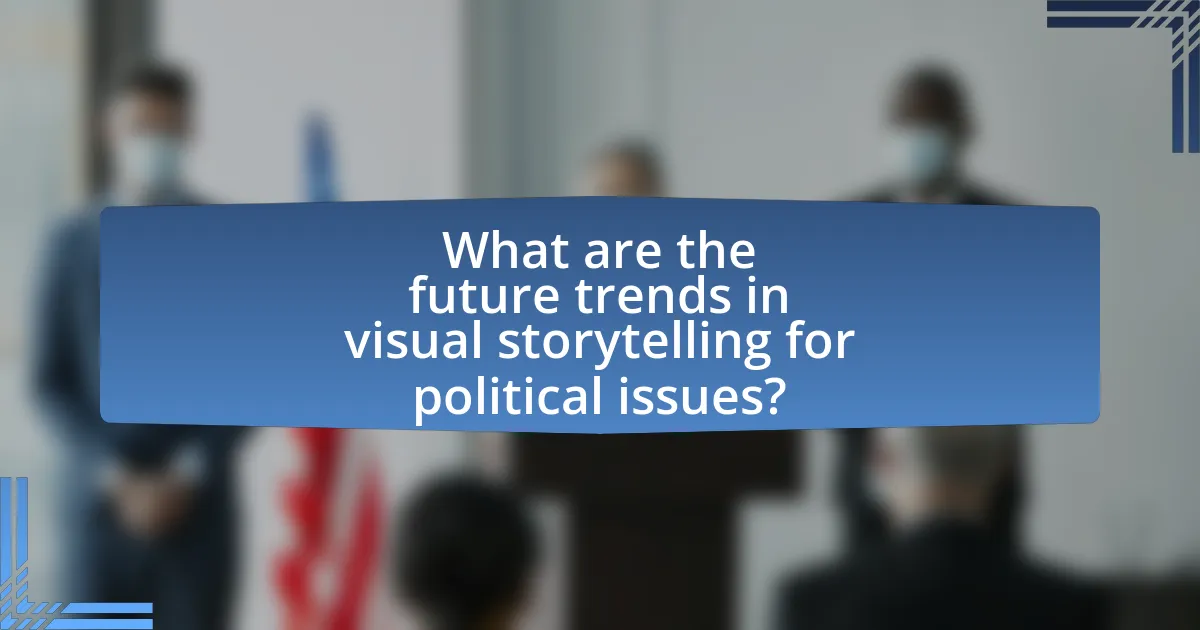
What are the future trends in visual storytelling for political issues?
Future trends in visual storytelling for political issues include the increased use of augmented reality (AR) and virtual reality (VR) to create immersive experiences that engage audiences more deeply. These technologies allow users to interact with political narratives in a way that traditional media cannot, enhancing emotional connections and understanding. Additionally, data visualization will become more prevalent, enabling complex political information to be presented clearly and effectively, thus improving public comprehension. The rise of social media platforms will further drive the trend towards short, impactful visual content that can be easily shared, increasing the reach and influence of political messages. Research indicates that visual content is processed 60,000 times faster than text, underscoring its effectiveness in shaping public perception.
How is technology changing the landscape of visual storytelling in politics?
Technology is transforming visual storytelling in politics by enabling more dynamic and interactive content that engages audiences effectively. The rise of social media platforms, such as Twitter and Instagram, allows political messages to be conveyed through images, videos, and infographics, reaching wider audiences instantly. For instance, during the 2020 U.S. presidential election, candidates utilized platforms like TikTok to create short, impactful videos that resonated with younger voters, demonstrating the shift towards visual-centric communication. Additionally, advancements in data visualization tools allow for complex political issues to be presented in a more digestible format, enhancing public understanding and engagement. This evolution in technology not only changes how political narratives are constructed but also influences public perception by making information more accessible and visually appealing.
What advancements in digital media are influencing visual narratives?
Advancements in digital media that are influencing visual narratives include augmented reality (AR), virtual reality (VR), and interactive storytelling platforms. These technologies enhance user engagement by allowing audiences to experience narratives in immersive environments, thereby deepening emotional connections and understanding of political issues. For instance, AR applications can overlay information onto real-world settings, while VR can transport users to pivotal historical moments, making complex political topics more relatable. Research indicates that immersive experiences can significantly impact viewers’ perceptions and attitudes, as evidenced by studies showing that VR experiences related to social issues can lead to increased empathy and awareness among participants.
How can data visualization enhance political storytelling?
Data visualization enhances political storytelling by making complex data more accessible and engaging for the audience. By transforming statistics and trends into visual formats such as charts, graphs, and infographics, political narratives become clearer and more compelling. For instance, a study by the Pew Research Center found that visual content is 40 times more likely to be shared on social media than text-based content, indicating that visuals can significantly increase audience engagement and retention of information. This increased engagement allows political messages to resonate more deeply, influencing public perception and understanding of critical issues.
What best practices should be adopted for effective visual storytelling in politics?
Effective visual storytelling in politics should prioritize clarity, emotional engagement, and authenticity. Clarity ensures that the message is easily understood, which is crucial in a political context where complex issues are often simplified for public consumption. Emotional engagement captures the audience’s attention and fosters a connection, making the political narrative more relatable. Authenticity builds trust, as audiences are more likely to respond positively to genuine representations of political figures and issues.
Research indicates that visuals can significantly influence public perception; for instance, a study by the Pew Research Center found that 64% of Americans believe that images can shape their views on political issues. By employing these best practices—clarity, emotional engagement, and authenticity—political communicators can enhance the effectiveness of their visual storytelling and positively impact public perception.
How can political communicators measure the impact of their visual storytelling efforts?
Political communicators can measure the impact of their visual storytelling efforts through metrics such as engagement rates, audience reach, and sentiment analysis. Engagement rates, including likes, shares, and comments, provide quantitative data on how audiences interact with visual content. Audience reach indicates the number of individuals exposed to the visual storytelling, which can be tracked through analytics tools. Sentiment analysis, utilizing natural language processing, assesses audience reactions and emotions towards the visuals, revealing how effectively the storytelling resonates with the public. Studies have shown that visual content can increase engagement by up to 94%, highlighting its significance in shaping public perception of political issues.
What are the key takeaways for creating compelling visual narratives in political contexts?
Creating compelling visual narratives in political contexts requires clarity, emotional resonance, and strategic framing. Clarity ensures that the message is easily understood, as seen in successful campaigns like Barack Obama’s 2008 election, where simple visuals conveyed complex ideas effectively. Emotional resonance engages the audience, as demonstrated by the use of powerful imagery in the “I Have a Dream” speech, which evoked strong feelings and motivated action. Strategic framing shapes how the audience interprets the narrative; for instance, the framing of climate change as an urgent crisis has mobilized public support for environmental policies. These elements combined enhance the impact of visual storytelling on public perception of political issues.
